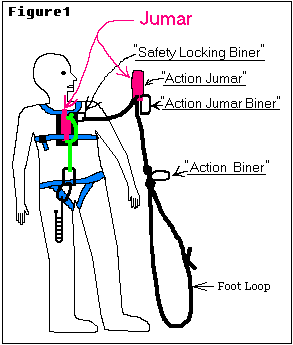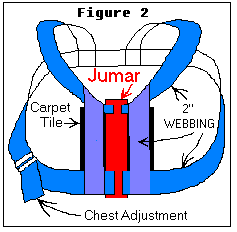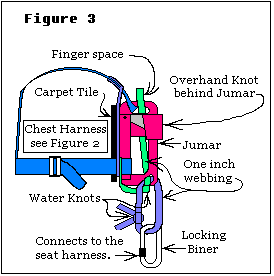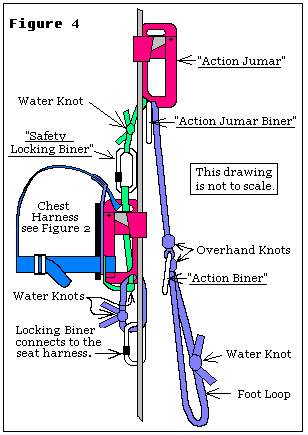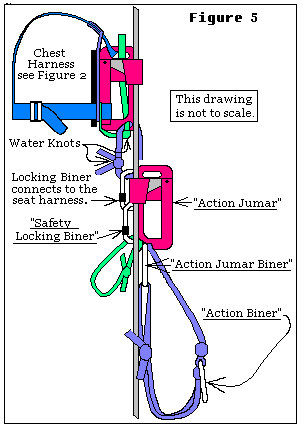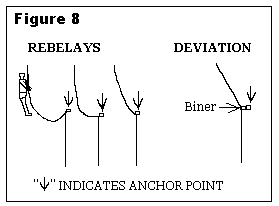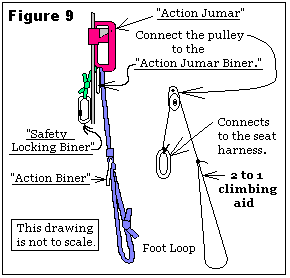ONE MAN'S VERTICAL SYSTEM
Revision #1By Bob Johnson
My name is Bob Johnson, NSS # 35023. I have been the Willamette Valley Grotto's vertical chairman for several years. I have been setting up vertical caving rope practices with an obstacle course. I try to simulate real cave conditions the best I can in the practice area. I like doing vertical rope work so I wanted to be able to do all of the obstacle courses easily. This forced me to modify my system many times to make it the easiest for all possible situations. I also wanted it simple and not too expensive. When fellow cavers would let me explain my system and tried it, they all wanted me to write to the NSS to share the features of my system. So here goes!!
FIRST THINGS FIRST
The first thing that I would like to do is to quote an article from the book "On Rope," Copyright 1987 National Speleological Society, entitled "Climbing Systems" on page 173, reprinted with permission from the NSS:
"The ideal climbing system should enable the climber to move comfortably and efficiently up the rope. It should provide a secure attachment to the rope, yet be easily removed as well as attached. It should fit the climber properly, be easily taken on and off with ease. It should be lightweight and not bulky. A good system is versatile, able to accomplish a variety of tasks such as being transformed into a rescue haul system. It should be redundant so that any failure will not place the climber in immediate danger. After a component failure, it should have the versatility to be transformed into a system enabling the climber to continue up or down safely. A system should be durable and incorporate interchangeable replacement parts. A good system climbs a wall as well as a free drop and allows a climber to ascend over difficult lips. Systems that fit climbers of different sizes are useful during rescues and training seminars. A great system incorporates the ability to downclimb."
|
DESCRIPTION / CONSTRUCTION
The first important thing is a good seat harness. My seat harness is a Gibbs style. The second important thing is a chest harness. (See CHEST HARNESS) They must be connected together since rescue work requires that the seat harness be connected to the chest harness. (See CHEST TO SEAT CONNECTION.) I use two-inch webbing for all of my harnesses. |
|
CHEST HARNESS
The chest harness is hand made. It has a webbing strap around the chest just under the tender area of the armpits and two shoulder webbing straps connected in back. The webbing around the chest should include an adjustable connection device making it comfortable for both male and female users. The chest webbing and shoulder webbing are sewed to a piece of carpet tile (padding) and through a Jumar ascender. Use a left-handed Jumar here for a right-handed person. I found that the Jumar ascender works the best. The webbing should be sewn tightly and attached safely to the Jumar so that the Jumar is held upright and as high as possible on the chest. The chest strap goes through the Jumar's handle and is sewn tightly to the Jumar. The shoulder straps go through the top hole of the Jumar. I added two short webbing straps, one on each side of the Jumar. These straps are sewn to the shoulder straps and to the carpet tile and to the chest strap. (See Figure 2.) The short webbing straps help to prevent the shoulder and chest straps from pulling out of the carpet tile. The Jumar's opening for the rope is held away from the body. The Jumar is free to operate smoothly but it is sewn securely to the chest harness so it will not move on the chest. If all was done correctly and you were on your back, you could be picked up by the Jumar's handle like a suitcase. This Jumar, when connected to the seat harness properly and on rope, will allow you to rest in a seated position. |
|
CHEST TO SEAT CONNECTION
Connecting the chest harness to the seat harness is done with the best one-inch webbing. I suggest a piece that is about four feet long. Find the halfway point. Put one side through the top Jumar hole and tie an overhand knot. (See Figure 3.) Overhand knot procedure: The end loop should be neat and about two inches long and connected through the top hole of the Jumar. Adjust if necessary. Place one loose end through the bottom hole of the chest Jumar and tie a water knot. If all was done right, the webbing should be smooth and tight when one finger is placed in the top loop above the Jumar. The webbing should be near the rope-guide cam area of the Jumar but on the other side of the metal rope guide. The ends should be sewed to the carpet tile so that the top loop maintains the finger space. (See Figure 3.) Take another piece of one-inch webbing about two to three feet long and place one end through the bottom hole in the Jumar and through the loop you just made near the water knot. Be sure it's through the loop and the hole because it's your safety connection. The ends should be tied with a water knot at a length that will allow you to connect the webbing to your seat harness with a locking biner. (See Figure 3.) I like to secure the ends by sewing them down. |
CHECK IT
If you assembled the chest harness and connected the seat harness connection properly you will stand hunched over. If you didn't, and you are standing straight up, then the chest harness will ride up and be in your face while you are on rope. A properly adjusted harness allows you to be in a comfortable sitting position off rope or on rope, even if you are unconscious. When not on rope, I unclip the chest harness from the seat harness and insert an additional biner so I can stand straight. Leave the two harnesses connected for safety! Be sure to remove the extra biner when you are about to go on rope.
COW'S-TAIL
A safety Jumar or cow's-tail! Some climbing systems really need a safety Jumar when making a changeover from rappel to climb, or climb to rappel, or when passing an anchor point. So I said to myself: "Why not incorporate it into the basic system. No chance of dropping it then." I use the "Inchworm" / "Frog" climbing system. This system uses a safety Jumar or "action Jumar" (my name for clarity) and it has three things attached to the bottom hole in the Jumar. (See No. 1 through 3.) I used the best one-inch webbing for all of these.
|
1. This attachment is the safety attachment. In the top loop of the chest harness Jumar, clip in a locking biner. We will call this the "safety locking biner." Be sure to clip it onto the webbing only that is in the top hole of the Jumar. This webbing is your safety connection if the chest harness Jumar is broken. It connects to the seat harness. (See Figure 4.) To make the webbing measurements easier put on your seat harness and your chest harness and connect them together. Clip your chest harness Jumar onto a suspended rope and sit in the harness. While hanging on the rope, clip on another Jumar above your chest Jumar. Use a right-handed Jumar for a right-handed person. I call this the "action Jumar." Grasp the "action Jumar" in the handle with your right hand and put your left hand on the top and sides, then slide it up the rope as far as it is comfortable. This is the travel length that you can use. (I get about 15-16 inches.) Be sure that the rope in the rope-guide cam is close to your head. The Jumar should be in the up position so you can work the release easily with your right thumb. Tie a loop of webbing through the bottom hole of the "action Jumar" and through the "safety locking biner" that is clipped onto the loop at the top of the chest harness Jumar. Be sure that the "safety locking biner" is held up tight when you tie your water knot. (See Figure 4.) I also sewed the ends down. 2. You should still be suspended on the rope. The next attachment uses a piece of webbing about eleven or more feet long, depending on your height. Find the halfway point and put one end through the bottom hole in the "action Jumar." Pull one side down about a foot and a half to make it uneven. Push the "action Jumar" up as far as the attachment to your chest harness will allow. The loose webbing should now be hanging in front of you. Grab about the middle of the two ends and tie an overhand knot in the webbing with the knot at the midpoint of your chest Jumar. Now tie another overhand knot one inch below that. Spread apart the short section between the two knots and put in a non-locking biner. This is the "action biner." (See Figure 4.) Next, raise one knee so your upper leg is horizontal with the floor. Put one end of the webbing under your foot and tie a water knot with the remaining end. The knot should not be under your foot but along the side of your leg. This is your foot loop. You may need to adjust this after you see how it works. I sewed the ends. 3. The last attachment is a non-locking biner placed in with the webbing in the bottom of the "action Jumar." It will be called the "action Jumar biner." (See Figure 4.) |
RAPPELLING DEVICE AND EXTRA ITEMS
A Rack or SRT (Single Rope Technique) for rappelling is locked onto the seat harness with a locking biner. This concludes the construction. Extra items for all the features would be: a pulley, three extra biners, short loop of one-inch webbing, long loop of one-inch webbing, prusik loop of small diameter climbing rope, and a long line of small diameter climbing rope for the 2 to 1 rescue procedure.
NO CHICKEN LOOPS
Why such a big foot loop and no chicken loops? Chicken loops indicate to me that the system will let you go upside down if one component fails. No one should ever have that happen! If your system would do it, fix it! My system does not need the chicken loops because if one component failed it would not let the person hang upside down. When climbing, the big loop is used to put your feet and your knees in when you want to rest completely. Your legs now make a nice place to put things that you want to set down temporarily. If the "action biner" is clipped to your descending device, when you are rappelling, the big loop can support your feet on a free drop rappel.
HOW IT ALL WORKS
With both Jumars on the rope, sit suspended. You now can put one or both feet into the foot loop. Raise your foot loop leg(s) and at the same time slide the "action Jumar" up as far as it will go with both hands. I like to use both hands for exercise. Stand in your foot loop and at the same time pull down on the "action Jumar" and toward your chest Jumar. Your chest Jumar should feed the rope through. Sometimes it doesn't because the rope is very short below you. You can pull the rope down with one hand or trap the short end with your heels for starting. Next, sit down in the harness and repeat the process. When I am against a wall, I use one foot for balance and one foot in the foot loop. The large loop enables me to switch feet easily. This sit-stand method of climbing can easily cause a bouncing rhythm when you climb. If you do this, the rope above you may be sawed in half by a protruding rock. To prevent the bouncing rhythm from occurring, make the end part of your movements with a smooth gradual stop.
|
A second way to climb is to move the "safety biner" and clip it onto your seat harness biner. Move the "action Jumar" below the chest Jumar and clip it onto the rope. Take the bottom of the foot loop and clip it into one of the non-locking biners below the "action Jumar." You now can use the sit-stand method with one finger pulling up the bottom Jumar or put a bungie cord in it. This position is ideal for climbing up over a difficult lip where the rope is on the ground at the top of the climb. (See Figure 5.) |
DOWNCLIMBING
With both Jumars on the rope, sit suspended. (See Figure 4.) Lift your feet up and move the "action Jumar" down close to the chest Jumar and lock it. Stand in the loop and move the chest Jumar down almost as far as it can go by squatting down, and then lock it. Sit down and raise your feet and move the "action Jumar" down close to the chest Jumar and lock it. Stand in the loop.......etc.
RESTING
When you need to rest, the chest harness Jumar holds you in your last position. If you put the "action Jumar's" foot loop at the right height you can rest in a seated position. In some other systems, when you stop climbing, you have to squat down to get a device to jam so you can rest your muscles. Then you have to waste energy by standing back up to continue climbing.
IF ONE FAILS
If one Jumar should be broken or damaged by a rock, you still have one left to climb with. This is done by looping the rope, below the Jumar, around one raised foot. Bring up the down side of the rope and put it next to the rope above your foot. Grasp the two ropes in one hand to make a crude ascender. The sit-stand method still works up or down, it just takes longer and more energy. You have to keep making another crude ascender each time you use it. You can also use your rescue 2 to 1 climbing aid and your prusik loop, from your extra items, to replace the broken Jumar. (See Figures 6 & 7.)
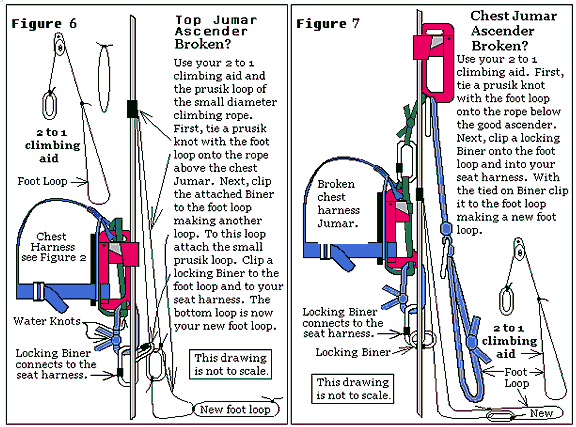
THE CHANGEOVER
The rappel changeover to ascend is very easy. I put on my climbing system when I rappel. You never know when you may have to change directions of travel when on rope. (See Figure 4.) First you tie off your rappel device, then clip your "action Jumar" onto the rope above the rappel device. Then remove your rappel device from the rope and clip on your chest Jumar. Start climbing.
The climbing changeover to rappel is easy too. Just stop climbing when the chest Jumar is near the "action Jumar" and then clip the "safety locking biner" into the "action Jumar biner." Downclimb the very short distance to release the pressure on the chest Jumar and release it from the rope. You now have access to the rope all the way to the bottom of the "action Jumar." Place your descending device on the rope as high as is easy. Lock it off. Next, unclip the two clipped together biners by standing in the foot loop and opening the non-locking biner. (Never unlock a locking biner when on the rope unless you are changing climbing modes described in HOW IT ALL WORKS.) Sit down in the harness, raise both feet that are in the foot loop, and remove the top Jumar. Release the descending device's lock carefully and rappel down. Sometimes some people let the descending device slip down so far that they can't get their weight off of the top ascender. If this happens just clip the "Action Biner" on the rope above the descending device. Stand in the foot loop and move the top Jumar down enough to get your weight onto the descender. Remove the ascenders and you are ready to rappel.
The tyrolean traverse changeover from a vertical rope is also easy. You just climb up, or down, so you can get your seat harness as close to the tyrolean traverse as you can. You will need from your extra items, the pulley, a short loop of webbing, and a locking biner. Without unlocking the seat harness biner, thread the loop of webbing through the seat harness biner. Then take the other end of the loop and put it through the first loop, trapping the seat harness biner on the loop. Then use the extra locking biner and clip it onto the other end of the webbing. Put the pulley on the tyrolean traverse and clip the biner onto the pulley. You may have to put your legs over the tyrolean traverse and raise your stomach to clip the biner. Downclimb so that almost all of your weight is on the tyrolean traverse. Unclip your chest Jumar. Bend one knee and make a loop or a circle around the toe of your foot with the rope you just climbed. Hold the down side of that rope up below the "action Jumar" next to the "action Jumar's" rope and grasp both ropes with one hand. Put your weight on the loop you just made and release the "action Jumar" with your other hand. If your tyrolean traverse is at a high point, then you can go for a ride by letting go of the foot loop rope. Point your toe, and the rope peels off. Watch out for your hair, or whatever, getting caught in the pulley.
If you don't want to coast, just clip your "action Jumar" onto the high side of the tyrolean traverse. Release the rope in your hand and undo your toe. When you are ready to travel down to the middle of the sag in the tyrolean traverse, you can downclimb the rope. You do this any way you can. One way is to rock your weight so on the upswing you can move the "action Jumar" down a little. Another way is to go hand over hand. Lastly, if the rope is very steep you can clip on your chest Jumar and downclimb. Remember the "action biner?" You can use it to support your feet by clipping it onto the rope and putting your feet in the foot loop.
Once you get to the bottom of the sag and you want to go up the other side, take everything off the rope except the pulley and the link hooked to your seat harness. The webbing link that was put on the seat harness will allow you to turn around without binding the pulley. Reverse the above procedures to get to the other end.
Once you can get to the other end's down rope, or up rope, just clip on your chest Jumar and your "action Jumar" and climb up so you can take off the pulley attachment. You are now ready to climb up or down without making the foot loop that was mentioned before.
PASSING OBSTACLES
Climbing past a knot or anchor point or changing ropes is very easy. You just move your two Jumars close together and close to the object. Then move the Jumar that is closest to the object, past the object. Downclimb or climb up to put the remaining Jumar close to the object. Move the first Jumar some more and then pass the object with the last Jumar.
To change ropes just clip the "action Jumar" onto the other rope, shift your weight and move the other Jumar over.
To rappel past a knot, you have to execute a changeover to the downclimbing mode. Pass the knot, and then change back.
|
REBELAYS
(See Figure 8.) To rappel past a reanchor, a looped rebelay, a loose rebelay, or a tight rebelay, all you have to do is change over to a climb and downclimb past the knot, or the anchor, or whatever. Change back to a rappel and you are on your way. DEVIATION (See Figure 8.) The loosely redirection biner rebelay (deviation) can be passed by rappelling an inch or two below the biner and locking off the descender. Take your "action Jumar biner" and clip it to the anchor. Put your weight on the foot loop. Move the redirection biner from below your rappel device and attach it on the rope above your rappel device. Put your weight back onto your descender and unclip the "action Jumar biner." Unlock your descender and finish the rappel. When climbing up and past a rebelay treat it like any other obstacle, except remember that you have an "action biner" and an "action Jumar biner" to help you shift your weight. |
CLIMBING SLOPES
When ascending a slope, the foot loop is not needed. Secure your foot loop out of the way by using one or more of the non-locking action biners.
TANDEM CLIMBING
The "action biner" is useful when you are on the top of a "tandem" climb. The "action biner," when clipped to the rope, will redirect the rope away from your crotch. This makes you more comfortable, helps to keep you more upright, and makes your climb easier.
ROPEWALKER SYSTEM
Some people just have to have a ropewalker system. On my system, for the very long climbs, I can add a foot ascender attached to the ankle/foot area. A bungie cord attached to the top of the ascender and to the harness makes this work very well.
RESCUE
If you need to rescue someone who is on the rope and you are below them, this system will let you climb past. You just treat them like any other obstruction, except that it is more awkward. As you pass the person, clip onto the upper part of the person's harness with your extra biners and webbing and then to your seat harness. Make the webbing length sufficient so you can climb above the person and you won't hit them with your feet.
|
I found some people so heavy that I could only lift them about one or two inches at a time. This was unacceptable to me, so I found that a 2 to 1 climbing aid was helpful. (See Figure 9.) From your extra items, clip the pulley onto your "action Jumar biner" and make a new foot loop from the long line of small diameter climbing rope. Copy the one that's on your system, but leave off the extra knot and the "action biner." Take the free end of the rope and put it through the pulley. Attach the end to your seat harness. With the "action biner" missing, you now can raise your legs higher. By yourself, you can get about the same amount of climbing distance. With a victim, you still climb with the "action Jumar" as before, but much easier. It helps to have the loaded webbing in front of your foot loop and between your toes. If you want to rescue someone who is below you, you may have to downclimb all the way. I think you will be glad to have my system for that. |
DISCLAIMER
Caving and climbing ropes or rappelling is dangerous. If you would like to build my system, go ahead and do it, but have someone who has been doing vertical caving for many years check your work. After you've constructed the system, also have them make sure you are using it correctly.
QUESTIONS
If you have questions about my system or would like to communicate with me, I can be reached by email: robert.johnson56@worldnet.att.net.
Return to the Top of the Page
Return to the NH #45 Contents Page
Copyright © 2000 Vertical Section of the NSS, Inc. - All Rights Reserved.
